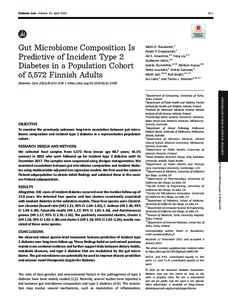Gut Microbiome Composition Is Predictive of Incident Type 2 Diabetes in a Population Cohort of 5,572 Finnish Adults
Ruuskanen Matti O.; Erawijantari Pande P.; Havulinna Aki S.; Liu Yang; Méric Guillaume; Tuomilehto Jaakko; Inouye Michael; Jousilahti Pekka; Salomaa Veikko; Jain Mohit; Knight Rob; Lahti Leo; Niiranen Teemu J.
https://urn.fi/URN:NBN:fi-fe2022081153740
Tiivistelmä
OBJECTIVE
To examine the previously unknown long-term association between gut microbiome composition and incident type 2 diabetes in a representative population cohort.
RESEARCH DESIGN AND METHODS
We collected fecal samples from 5,572 Finns (mean age 48.7 years; 54.1% women) in 2002 who were followed up for incident type 2 diabetes until 31 December 2017. The samples were sequenced using shotgun metagenomics. We examined associations between gut microbiome composition and incident diabetes using multivariable-adjusted Cox regression models. We first used the eastern Finland subpopulation to obtain initial findings and validated these in the western Finland subpopulation.
RESULTS
Altogether, 432 cases of incident diabetes occurred over the median follow-up of 15.8 years. We detected four species and two clusters consistently associated with incident diabetes in the validation models. These four species were Clostridium citroniae (hazard ratio [HR] 1.21; 95% CI 1.04–1.42), C. bolteae (HR 1.20; 95% CI 1.04–1.39), Tyzzerella nexilis (HR 1.17; 95% CI 1.01–1.36), and Ruminococcus gnavus (HR 1.17; 95% CI 1.01–1.36). The positively associated clusters, cluster 1 (HR 1.18; 95% CI 1.02–1.38) and cluster 5 (HR 1.18; 95% CI 1.02–1.36), mostly consisted of these same species.
CONCLUSIONS
We observed robust species-level taxonomic features predictive of incident type 2 diabetes over long-term follow-up. These findings build on and extend previous mainly cross-sectional evidence and further support links between dietary habits, metabolic diseases, and type 2 diabetes that are modulated by the gut microbiome. The gut microbiome can potentially be used to improve disease prediction and uncover novel therapeutic targets for diabetes.
Kokoelmat
- Rinnakkaistallenteet [27094]
